 January 2004
January 2004
The Daley News
Drying your excess fruit
Are you being swallowed by excess fruit? Here's some sweet ideas.
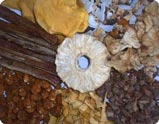 Tropical fruits often bear heavily for a relatively short bearing season. This can often result in a fermenting pile of mush under the tree and leave us pining for just one more mango or star fruit for the remaining 11 months of the year. For many years canning and bottling have been the most popular methods of savouring the flavour but both present problems in outlay of capital and storage space.
Tropical fruits often bear heavily for a relatively short bearing season. This can often result in a fermenting pile of mush under the tree and leave us pining for just one more mango or star fruit for the remaining 11 months of the year. For many years canning and bottling have been the most popular methods of savouring the flavour but both present problems in outlay of capital and storage space.
One of the oldest ways of preserving food is drying and with the revival of natural methods drying is presently undergoing a world wide revival, it being both low in cost and efficient in use of energy.
Properly dried food is nutritionally superior to canned or bottled food, flavour and colour are maintained, only 1/6th if the space is required, dried food is instant food and can be eaten without further preparation. Drying requires a fairly constant temperature of between 32 and 60 degrees Celsius, with the majority f fruits during best at around 43 degrees. A considerable proportion of the world’s dried fruit (apricots, apples etc) are naturally sun dried. This method is ideal for many parts of Australia. It can be as simple as spreading the fruit evenly on trays covered with netting to keep off the insects. Sun drying has several advantages. Costs are low, the only investment being the drying trays the protective netting. The suns ultra violet rays have a sterilizing effect which slows the growth of some micro-organisms and sun dried fruit usually retains an attractive colour.
The disadvantages are varying weather conditions and the time required. The time varies depending on the fruit, but as a general, with the weather on your side, a fruit such as an apricot will require 4-5 days compared to approx 8 hours in an electrical fan forced dehydrator.
The theory of drying requires not only heat but the moisture driven off must be absorbed into the air and dispersed. Therefore the requirement is for warm, very dry air. This can be a problem in Far North Queensland or other more tropical conditions where the relative humidity is usually too high for normal air flow to carry off this moisture. Such high humidity can cause problems with mould. In such conditions a cabinet drier heated artificially and thermostatically controlled with fan forced air circulation may be required. 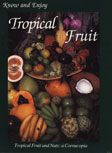
Some of the easiest tropical fruits to dry are Bananas, Mangos, Guava, Lychess, Pinapple and Papaya. James Darley has a few fabulous recipes and recommendations for drying fruit and making fruit leathers in his book "Know and Enjoy Tropical Fruit" available from us for $39.95 plus p&h.
Some of our customers may have considerable experience with various types of dryers and might like to share their experiences. We would be delighted to receive letters of your experiments with fruit drying to share among our readers in future newsletters.
Orchard tips for a better design
There are many paths to planning your orchard and a number of different philosophies behind them all. In this short article I will skim over a few ideas and touch on some general approaches. If anyone is interested in further information, please feel free to contact us here at Daleys Fruit Tree Nursery
Food Foresters- The popularity for a natural farming approach is gaining more momentum as our society as a whole is increasing environmental awareness and improving its efforts towards more sustainable management strategies of cropping and agriculture.
Here at Daleys, we have found that the interest for growing food on the small/home  scale is consistently increasing and many of this fresh new enthusiasm is inspired by low input, low maintenance designs that enable busy people to have some fresh fruit from their backyard. A disciple to this approach will generally avoid the high maintenance path of pruning and fertilizing trees and encourage a forest like environment, (including the breakdown of plant material and the use of cover cropping to contribute the fertilizer for the trees) replicating the indigenous forest situation from which our fruit trees originate.
scale is consistently increasing and many of this fresh new enthusiasm is inspired by low input, low maintenance designs that enable busy people to have some fresh fruit from their backyard. A disciple to this approach will generally avoid the high maintenance path of pruning and fertilizing trees and encourage a forest like environment, (including the breakdown of plant material and the use of cover cropping to contribute the fertilizer for the trees) replicating the indigenous forest situation from which our fruit trees originate.
An example of this is the suggestion that Avocados prefer large woody litter, branches etc as mulch under the tree rather than a clear area with regular fertilizer application.
An interesting book to read if inspired by such a strategy is “Natural Farming” by Masanobo Fukuoka (a Japanese Farmer who promotes minimal input farming).
Permaculture as a design system that has grown from the natural farming philosophy. Designing orchards based on permaculture principles aims to develop a healthy and diverse planting design that will get as close to self maintaining as possible. In permaculture systems, growers may apply some of the following ideas:
- use foraging chickens under fruit trees to assist in pest control, orchard hygiene and fertilizer application (chicken manure)
- use nitrogen fixing ground covers and/or support trees to assist in fertilizing the trees (such as pinto peanut, crotalaria, pigeon peas, acacias)
- plant diverse range of fruit trees to allow some fruit ripening throughout the year
- plant trees in such a way that they support each other in a forest like environment ie. Mammy sapotes have a traditional use of providing part shade and protection among coffee plantations in the Americas.
- Establish microclimates for different trees to provide for their needs ie. Hot spots for the bananas and mangos, extra drainage for olives, shaded positions for some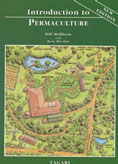 of the exotic tropicals.
of the exotic tropicals.
- Placing the trees in proximity to your house according to type of harvest ie. Regular harvest of small crops (berries, acerolas) closer to your main pathways, Bulk harvest trees (avocados, sapotes) further a field.
- Plant interim crops in between the longer term larger trees ie. Use bananas and pawpaws to fill the spaces between young avocado trees, providing shelter for the avocados as they grow.
An excellent book that explores this integrated approach is Linda Woodrows "The Permaculture Home Garden" or Bill Mollisons "Introduction to Permaculture" available from www.greenharvest.com.au
The more common conventional style of growing fruit trees follows a scientific evaluation of the fruit trees needs and determines an efficient means of providing for these needs. This is the basis of commercial farming practice. Planting a single species (monocropping) has its benefits as the trees nutritional needs and management methods can be applied consistently throughout the planting as well as ensuring the consistency of the harvest. This approach aims for highest possible production of best quality stock in the most cost effective and efficient way.  Techniques used in this style of growing trees include soil and foliage analysis, plant nutrition plans, pest management plans etc. In a mixed backyard orchard the strengths of this approach can be also be implemented by analysing your soils and site and determining the right positions for the varying sorts of trees and grouping trees together according to their needs. This is an important consideration when planting trees that are prone to bird/bat and fruit fly attack. You may wish to group them together if you are considering netting an area or you may wish to spread them widely in hope that the critters will not find them all.
Techniques used in this style of growing trees include soil and foliage analysis, plant nutrition plans, pest management plans etc. In a mixed backyard orchard the strengths of this approach can be also be implemented by analysing your soils and site and determining the right positions for the varying sorts of trees and grouping trees together according to their needs. This is an important consideration when planting trees that are prone to bird/bat and fruit fly attack. You may wish to group them together if you are considering netting an area or you may wish to spread them widely in hope that the critters will not find them all.
In between these approaches is a plethora of other ideas. It is an enjoyable learning experience to explore the alternatives, select the best bits from all and then compile the ideas that work best for you for your own unique plan.
Our Favourite Fruit of the Month
GULF GOLD PLUM, Prunus salicina
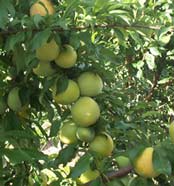 This low chill plum has proven itself a winner this last month and I am compelled to share with you its virtues. We have a single tree here in our new stock tree orchard, just 18 month old and has been dripping in hundreds of fruit ripening over the last 6 weeks. The tree is undoubtedly self pollinating and while so many other stone fruit are victim to the fruit fly, this tree has not a spot of fruit fly and grown without any use of sprays at all. Growers, closer to the coast in warmer areas, have also shared comparative stories of success. This tree would make the perfect, prolifically bearing, potted plum. It is the most dwarf growing of our plums hence ideal for the backyard.
This low chill plum has proven itself a winner this last month and I am compelled to share with you its virtues. We have a single tree here in our new stock tree orchard, just 18 month old and has been dripping in hundreds of fruit ripening over the last 6 weeks. The tree is undoubtedly self pollinating and while so many other stone fruit are victim to the fruit fly, this tree has not a spot of fruit fly and grown without any use of sprays at all. Growers, closer to the coast in warmer areas, have also shared comparative stories of success. This tree would make the perfect, prolifically bearing, potted plum. It is the most dwarf growing of our plums hence ideal for the backyard.
The fruit are golden in colour with a red tinge when perfectly ripe.
Our Exotic Fruit of the Month
CHERRY OF THE RIO GRANDE, Eugenia aggregata
 This beautiful small tree has very attractive dark glossy-green waxy leaves and a peeling bark. The showy white flowers are followed by deep purple plum sized fruit approximately 3 weeks from the time of flowering. The fruit is the most popular substitute for the traditional ‘Prunus’ Cherry for warmer climates. The fruit has a sweet juicy cherry flavour eaten fresh or can be picked at maturity , frozen for later use or used in jellies, jams and juices.
This beautiful small tree has very attractive dark glossy-green waxy leaves and a peeling bark. The showy white flowers are followed by deep purple plum sized fruit approximately 3 weeks from the time of flowering. The fruit is the most popular substitute for the traditional ‘Prunus’ Cherry for warmer climates. The fruit has a sweet juicy cherry flavour eaten fresh or can be picked at maturity , frozen for later use or used in jellies, jams and juices.
This compact tree is perfect for small back yard orchards as it is well suited to container growing, still producing an abundance of fruit even when kept as a potted bush. This is advantageous as the tree can then be easily netted during fruiting time as this tree is a favourite to the birds. The tree is highly ornamental requiring very little attention and pruning to keep it looking its best. It can also be used to make a hedge.
The Brazillian tree, member of the Myrtaceae, can reach up to 10 metres in its tropical forest environment, but most often reaches a comfortable height of 4-5m. They are moderately fast, preferring frequent but small balanced nutrient application and regularly watering during flowering and fruit development although the tree itself, if not expecting fruit quality in the drier years is fairly drought tolerance. The tree can tolerate temperatures down to zero degrees.
Our Bushfood Tree of the Month
ANISEED MYRTLE, Backhousia anisata
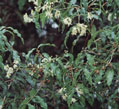 This stunning rainforest tree is both highly ornamental and a very desirable for its bushfood characteristics. It is quite rare in the wild, native to a few areas of N-E NSW however its popularity within the bushfood and horticultural industries promises its security within our flora environment.
This stunning rainforest tree is both highly ornamental and a very desirable for its bushfood characteristics. It is quite rare in the wild, native to a few areas of N-E NSW however its popularity within the bushfood and horticultural industries promises its security within our flora environment.
The tree can reach up to 45m in a rainforest environment but most often reaches 8-10 m as a small to medium tree in open garden situations and is usually harvested as a hedge to 2-3 m in bushfood plantations. The plant has a dense cover of fine lush green foliage throughout the year with white scented flowers in the spring.
The tree prefers regular watering and fertiliser to looks its best as a foliage feature plant. It will enjoy both full sun and part shade positions and makes an excellent tub specimen particularly when regularly pruned to encourage fresh tip growth.
Its name comes from the strong aniseed scented and flavoured leaves. The leaves are often used for flavouring desserts, sweet sauces and preserves. It also is popular as a scented savory sauce or marinade for meats and sets a deep fragrent flavour to salad dressings. See our tasty recipe below!!
Our Rainforest Tree of the Month
SANDPAPER FIGS, Ficus Coronata
Also a bush food, this has definately won the award for the best looking selection of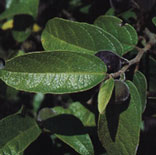 our tubestock at the moment. This particular strain is from a selection that produced lushious and very tasty figs, best eaten when soft and dark purple, which are comparable in taste to the meditarranian figs that we find on our market shelves. One of our keen customers even offered me the suggestion the other day of using the leaves as a scourer when washing up. Just plant one beside the kitchen window and away you go. The leaves have a traditional use among Indigenous Australians to sand back wooden articles to gain a smooth finish.
our tubestock at the moment. This particular strain is from a selection that produced lushious and very tasty figs, best eaten when soft and dark purple, which are comparable in taste to the meditarranian figs that we find on our market shelves. One of our keen customers even offered me the suggestion the other day of using the leaves as a scourer when washing up. Just plant one beside the kitchen window and away you go. The leaves have a traditional use among Indigenous Australians to sand back wooden articles to gain a smooth finish.
Usually a small tree reaching 8-10m at best in the rainforest but often only 3-4m in its common location on the banks of creeks. Very useful in restoration works, growing very fast in most soil types. 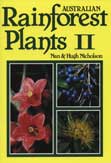
Photographs of Aniseed Myrtle and Sandpaper fig are thanks to Hugh and Nan Nicholson as part of the fabulous collection of photographs in their Rainforest Plants Series available from us for $16.95 each
The trees listed above and many more are available at Daleys Nursery. See our website at https://www.daleysfruit.com.au and go straight to the shopping trolley to order these plants or call in and see Emma at the Nursery for more information.
ANISEED MYRTLE DRESSING |
|
|
Ingredients: Stage 2 - Mix all ingrediants into a jar and shake until well mixed. Drizzle lavishly over fresh crusty bread with roasted capsicum, fetta cheese, a rocket leaf and maybe if your lucky some kangaroo prosciutto. Enjoy !! |
|

Healthy Soil Symposium.
The Soil Foodweb Institute, based in Oregan, New York, New Zealand, Holland, and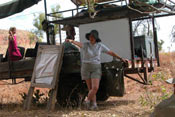 now at Lismore NSW has been operational locally since 2002. We quote from http://www.soilfoodweb.com/sfi_html/02_approach/index.html: “At Soil Foodweb, we know that to grow healthy, productive plants, you need healthy soil with the right balance of organisms. Our mission is to measure the quality and quantity of soil organisms and guide you to build your soil so your soil can build your plants.”
now at Lismore NSW has been operational locally since 2002. We quote from http://www.soilfoodweb.com/sfi_html/02_approach/index.html: “At Soil Foodweb, we know that to grow healthy, productive plants, you need healthy soil with the right balance of organisms. Our mission is to measure the quality and quantity of soil organisms and guide you to build your soil so your soil can build your plants.”
On February 4-6, 2004 the Soil Food Web Institute, (in conjunction with local sustainability specialists, Footprint Directions) will be conducting a healthy soil symposium in Byron Bay. Based on extensive microbiology research, the workshops will detail innovative theory, practical demonstrations and field experiments on the benefits of tending the microbial world under our feet and particularly in our gardens, orchards and paddocks. Dr. Elaine Ingham, Director of Research and President of the Soil Foodweb Institute, will conduct the two day structured workshops, and work collaboratively with three Australian compost and  compost tea brewing specialists on the third field day. Join Mike McCoster, Robbie Green and Steven Robideaux with Dr Ingham to discover this remarkable new science from age-old techniques.
compost tea brewing specialists on the third field day. Join Mike McCoster, Robbie Green and Steven Robideaux with Dr Ingham to discover this remarkable new science from age-old techniques.
SPECIAL OFFER: All Daleys newsletter subscribers are eligible for a discount of 5% for the symposium fees if they pay by internet transfer or cheque (and before 4 February). That equals $42.50 off the full 3 day fees.
For more information Click here or call Greg at Footprint Directions 0266882324 or email jane@footprintdirections.com
Next Issue
The World of Weeds - Cautions to consider for fruits






